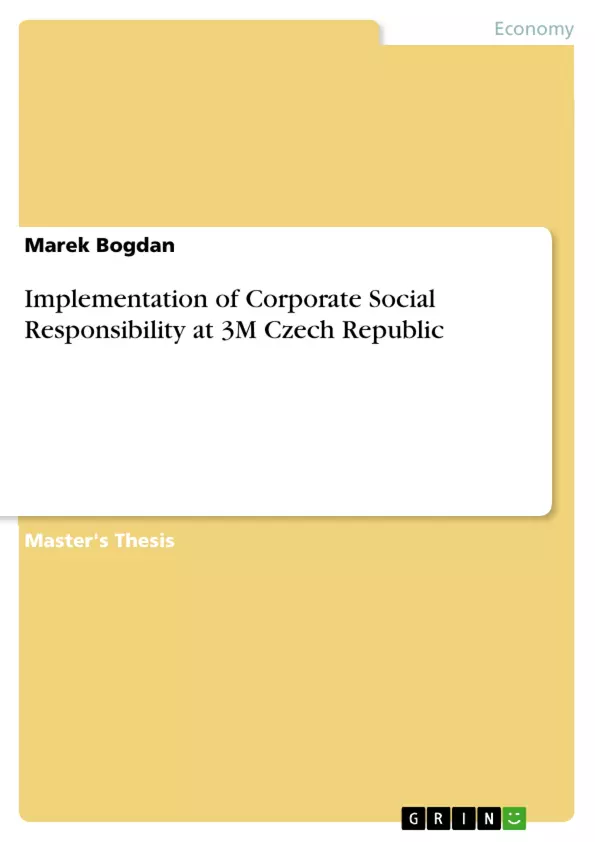The aim of this thesis is to present the top management of 3M Czech Republic with a comprehensive solution to their CSR implementation task. The thesis starts by giving the reader an insight into the today's forms of business ownership including corporations and by covering the issue of governance explains why corporations need a solution like CSR. Subsequently, the theoretical foundations of CSR are presented, followed by an explanation of the actual business tool. Additionally, a generic implementation roadmap is devised together with key success factors of this process identified. Based on this generic roadmap, a tailored solution for 3M Czech Republic including specific recommendations on measures and key performance indicators is developed.
Table of Contents
- Chapter 1: Introduction to the Subject
- Chapter 2: A Deep Dive into Core Concepts
- Chapter 3: Exploring Related Theories
- Chapter 4: Case Study Analysis and Interpretations
Objectives and Key Themes
The objective of this work is to provide a comprehensive exploration of a specific subject, analyzing core concepts and related theories. The work aims to contribute to a deeper understanding of the subject matter through detailed analysis and case studies.
- Core Concepts and Definitions
- Theoretical Frameworks and Models
- Empirical Evidence and Case Studies
- Implications and Applications
- Future Research Directions
Chapter Summaries
Chapter 1: Introduction to the Subject: This chapter lays the groundwork for the entire work, introducing the subject matter and its significance. It provides essential definitions, contextualizes the topic within a broader academic landscape, and outlines the key questions that will be addressed in subsequent chapters. The chapter establishes a clear structure and argumentative direction for the rest of the study, providing a framework for understanding the complex issues at hand. It sets the stage for the deeper dives into specific concepts and theories explored in later sections.
Chapter 2: A Deep Dive into Core Concepts: This chapter delves into the foundational concepts that underpin the subject. It provides detailed explanations, definitions, and illustrations of key terms, making it a crucial resource for understanding the complexities of the topic. This thorough exploration ensures that the reader has a solid grasp of the basic principles before progressing to more nuanced discussions in subsequent chapters. The chapter meticulously clarifies ambiguities and potential misconceptions, establishing a clear conceptual base for the arguments presented later.
Chapter 3: Exploring Related Theories: Chapter 3 examines various theoretical frameworks related to the central topic. It compares and contrasts different perspectives, highlighting their strengths and weaknesses, and demonstrating how they connect to the empirical evidence presented in later chapters. This comprehensive overview of relevant theories enriches the analysis by providing a multi-faceted perspective. The chapter serves as a crucial bridge between abstract theoretical considerations and concrete empirical findings.
Chapter 4: Case Study Analysis and Interpretations: This chapter presents detailed case studies that illustrate and support the theoretical arguments presented earlier. It analyzes specific instances of the phenomena under investigation, revealing intricate patterns and providing concrete examples to enhance understanding. These carefully selected cases showcase the practical application of the theoretical frameworks discussed in Chapter 3. The chapter meticulously analyzes the nuances and complexities of each case, connecting back to the core concepts outlined in Chapter 2. Each case study is carefully chosen to illustrate different facets of the central theme, thus offering a comprehensive and multifaceted view.
Keywords
Core concepts, theoretical frameworks, empirical evidence, case studies, subject matter analysis, implications, applications, future research.
Frequently Asked Questions: Comprehensive Language Preview
What is included in this language preview?
This preview provides a comprehensive overview of the publication, including the table of contents, objectives and key themes, chapter summaries, and keywords. It offers a structured and detailed look at the content before reading the full text.
What are the main chapters and their focus?
The publication is structured into four chapters: Chapter 1 introduces the subject matter and sets the stage for the analysis. Chapter 2 delves into core concepts and definitions. Chapter 3 explores related theories and compares different perspectives. Chapter 4 presents case studies to illustrate and support the theoretical arguments.
What are the key objectives and themes of this work?
The main objective is to offer a thorough exploration of a specific subject. Key themes include core concepts and definitions, theoretical frameworks and models, empirical evidence and case studies, implications and applications, and future research directions. The work aims to contribute to a deeper understanding of the subject through detailed analysis and case studies.
What does each chapter cover in detail?
Chapter 1: Introduction provides background information, definitions, and context. Chapter 2: Core Concepts offers detailed explanations of foundational ideas. Chapter 3: Related Theories compares and contrasts various theoretical frameworks. Chapter 4: Case Study Analysis presents detailed case studies to support the theoretical arguments, demonstrating practical application.
What are the key takeaways or keywords associated with this work?
Key terms include core concepts, theoretical frameworks, empirical evidence, case studies, subject matter analysis, implications, applications, and future research directions.
What is the intended audience or purpose of this preview?
This preview is intended for academic use, to provide a structured and professional overview of the publication's themes and content, aiding in the analysis of its subject matter.
Where can I find the full text of this publication?
The full text of this publication is not included in this preview. This is solely a preview intended for academic review and analysis.
- Arbeit zitieren
- Marek Bogdan (Autor:in), 2010, Implementation of Corporate Social Responsibility at 3M Czech Republic, München, GRIN Verlag, https://www.grin.com/document/179146



